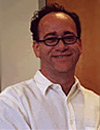Scientists figure out how an enzyme works by knowing its atomic structure

UCSF's Brian Shoichet
In the last 40 years, scientists have perfected ways to determine the knot-like structures of enzymes, but they’ve been stumped trying to translate the structure of enzymes into an understanding of their function - what they actually do in the body. This puzzle has hindered drug discovery, since many of the most successful drugs work by blocking enzyme action. Now, in an expedited article in “Nature,” researchers show that a solution to the puzzle is finally in sight.
A team co-led by UCSF’s Brian Shoichet describes the first success “decrypting” an enzyme’s function from its structure. If the new strategy works with other enzymes, it should become a potent tool to determine how key enzymes work in the body. Overactive, inhibited or damaged enzymes are key players in triggering disease, so the technique opens an efficient route to drug discovery, Shoichet says.
Schoichet is a professor of pharmaceutical chemistry and an investigator in the California Institute for Quantitative Biomedical Research, or QB3, based at UCSF.
The research was published online Sunday afternoon in an advanced online edition of Nature, and will appear later in the print edition.
The team’s success came by modifying a technique called molecular docking, a computer-aided modeling strategy used to search for potential drugs. Docking works by allowing researchers to first determine the atom-by-atom structure of an enzyme and then screen many thousands of molecules for one that fits into the empty “active site” of the enzyme. Shoichet calls this a search for the missing piece of a jigsaw puzzle. A molecule that fits the enzyme’s active site will block its activity - just what many promising drugs do.
The strategy works well for one kind of drug discovery—finding molecules to fit in the active site and physically block enzyme action. But the research team sought to divine from an enzyme’s structure just what natural molecule triggers the enzyme into action—fitting into the active site and enabling the enzyme to act as a catalyst. This was a search for the so-called substrate for the enzyme, a search that has never succeeded simply from knowing an enzyme’s configuration.
The key to the team’s success was a computational feat: simulating candidate substrates that mimicked unstable “intermediate” molecules - those that exist only briefly as the catalyst turns the substrate into a new molecule. Because these intermediates are unstable, scientists have until now been unable to test their fit to the enzyme’s active site.
Once the scientists had predicted the substrate, team member Frank Raushel, a professor of chemistry at Texas A&M University, tested the prediction experimentally. The results confirmed the prediction. Steven Almo, a professor of biochemistry at Albert Einstein College of Medicine, further confirmed the finding by determining the substrate’s atomic level structure through x-ray crystallography, a technique that uses x-rays to determine the arrangement of atoms within a compound.
“To tell the truth, we were very surprised that the docking approach worked to determine the substrate,” says Shoichet. “There’s so many ways that the approach can go wrong. We’re all very gratified.”
For their experiments, the team extracted an enzyme from a bacterium known as Thermotoga maritima, a microbe that normally lives at very high temperatures and pressures near volcanic ocean vents. Its structure was determined as a part of the structural genomics project, a large-scale, worldwide effort to determine the structures of enzymes and receptors.
With the nature of the substrate in hand, the scientists went on to discover that the enzyme works in a previously uncharacterized metabolic pathway in bacteria.
Lead author on the Nature paper is Johannes Hermann, a former postdoctoral student in Shoichet’s lab. Co-authors, along with Shoichet, Raushel and Almo, are Alexander Fedorov and Elena Fedorov, both staff scientists in biochemistry at Albert Einstein College of Medicine; and Ricardo Marti-Arbona, a graduate student at Texas A&M.
The research is supported in part by the National Institute of General Medical Sciences, one of the National Institutes of Health.
UCSF is a leading university that advances health worldwide by conducting advanced biomedical research, educating graduate students in the life sciences and health professions, and providing complex patient care.